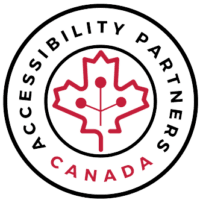As businesses began to adapt to the digital age, additional barriers for disabled citizens emerged. Technology continues to improve and provide convenience to society. However, barriers, such as inaccessible audio and visual content, continue to create unnecessary roadblocks for people with disabilities who are also looking to progress with society.
To provide disabled citizens with improved accessibility standards, Canada passed the Accessible Canada Act, also known as ACA.
The legislation was designed to improve the lives of Canadians with disabilities by removing barriers and ensuring they have the same opportunities and access to services as everyone else.
What is the Accessible Canada Act?
The Accessible Canada Act (ACA) is a federal law that guides businesses, the federal government, departments, and organizations in providing accessible services to persons with disabilities. The ACA is based on the principles of the United Nations Convention on the Rights of Persons with Disabilities, designed to eliminate barriers preventing individuals with disabilities from fully participating in society.
As the first piece of national accessibility legislation in Canada, the Accessible Canada Act outlines various measures that organizations must take.
Organizations in Canada are required to promote accessibility to those working within their sector and to those that rely on their services. To ensure that organizations are taking the right steps in improving their accessibility standards, the Accessible Canada Act requires regulated entities to:
- Develop, execute, and publish progress reports on new accessibility standards and regulations.
- Audit, identify, and remove existing accessibility barriers.
- Update and distribute information and communication materials in accessible formats.
The ACA is a reminder that accessibility is not just a matter of compliance but a fundamental human right that must be prioritized in all aspects of Canadian society.
Types of Accessibility Laws and Legislation in Canada
After the Accessible Canada Act was introduced, the provinces decided to take extra measures.
The Accessible Canada Act targets Canada as a whole. However, Ontario, Manitoba, Nova Scotia, British Columbia, and Quebec introduced additional legislation to help improve accessibility standards within their own province.
These legislations include:
- Accessibility for Ontarians with Disabilities Act (AODA)
- The Accessibility for Manitobans Act (AMA)
- Nova Scotia Accessibility Act (NSAA)
- Accessible British Columbia Act (ABCA)
- Quebec Accessibility Act (QAA)
While still acknowledging the federal Accessible Canada Act, these provinces created extra measures to ensure those with disabilities were receiving equal opportunities as those without disabilities. In fact, there are five main areas in which the acts focus on improving their accessibility standards:
- Customer service
- Employment
- Communication and information
- Transportation
- Buildings and outdoor spaces
Although the provinces all focus on improving accessibility standards in the same areas, each province has a unique deadline, with additional requirements for organizations registered in their province.
1. Accessibility for Ontarians with Disabilities Act (AODA)
Legislation date and deadline:
The AODA was passed in 2005 and aims to make Ontario accessible by 2025.
Legislation’s target:
The legislation targets all public and private sector organizations with one or more employees in Ontario.
Legislation’s requirements:
Organizations must follow AODA standards to create policies, practices, and accessibility plans that identify, remove, and prevent barriers to full and equal participation for people with disabilities.
2. The Accessibility for Manitobans Act (AMA)
Legislation date and deadline:
The AMA was passed in 2013 and aims to make Manitoba accessible by 2023.
Legislation’s target:
The legislation targets all public and private sector organizations that:
- Provide employment opportunities
- Provide accommodations
- Own, operate, maintain, or control an aspect of the built environment
- Provide goods, services, or information.
Legislation’s requirements:
Organizations must create policies and practices that identify, remove, and prevent barriers for people with disabilities and submit their accessibility plans and progress reports.
3. Nova Scotia Accessibility Act (NSAA)
Legislation date and deadline:
The NSAA was passed in 2017 and aims to make Nova Scotia accessible by 2030.
Legislation’s target:
The legislation targets all public and private sector organizations with 50 or more employees in Nova Scotia.
Legislation’s requirements:
Organizations must meet the following requirements:
- Create policies, practices, and accessibility plans that identify, remove, and prevent barriers for people with disabilities.
- Conduct research, and develop and implement public education and awareness programs.
- Submit accessibility plans and progress reports to the organization’s website or the Nova Scotia’s Accessibility Commissioner.
4. Accessible British Columbia Act (ABCA)
Legislation date and deadline:
The ABCA was passed in 2020 and aims to make British Columbia accessible by 2030.
Legislation’s target:
The legislation targets all public and private sector organizations with 50 or more employees in British Columbia.
Legislation’s requirements:
Organizations are required to create accessibility plans that identify, remove, and prevent barriers for people with disabilities and review and update the plan at least once every three years.
5. Quebec Accessibility Act (QAA)
Legislation date and deadline:
The QAA was actually one of the first accessibility legislation passed in Canada, dating back to 1978. It then updated its legislation in 2004 specifically to, “Act to secure handicapped persons in the exercise of their rights with a view to achieving social, school, and workplace integration.”
Legislation’s target:
The legislation targets all public sector organizations with one or more employees in Quebec.
Legislation’s requirements:
Organizations are required to use the legislature as a guide:
- Adopt new approaches that respect and facilitate handicapped persons capacities.
- Facilitate the services offered to handicapped persons.
- Prioritize resources and services that allow handicapped persons to live normal lives.
- Update built environments for handicap accessibility.
How familiar are you with Canada’s and your province’s accessibility legislation?
The Accessible Canada Act is a critical piece of legislation that seeks to promote and protect the human rights of individuals with disabilities and create a barrier-free Canada.
The act not only recognizes the importance of accessibility in creating a more inclusive society, but it also provides a framework for ensuring that all Canadians have the same opportunity and equal access to:
- Goods
- Information and communication technologies
- Services and
- Facilities
Because the ACA and the individual acts described in the provinces above represent a significant step forward, it is important to note that much work must be done to ensure that accessibility is fully integrated into all aspects of Canadian life.
Accessibility Partners provides educational services for organizations and their staff, as well as accessibility consultations to ensure your organization abides by the ACA and the legislation of your province.
Click below for a consultation to ensure you’re up to speed with the ACA and your province’s accessibility legislation. Contact Accessibility Partners

